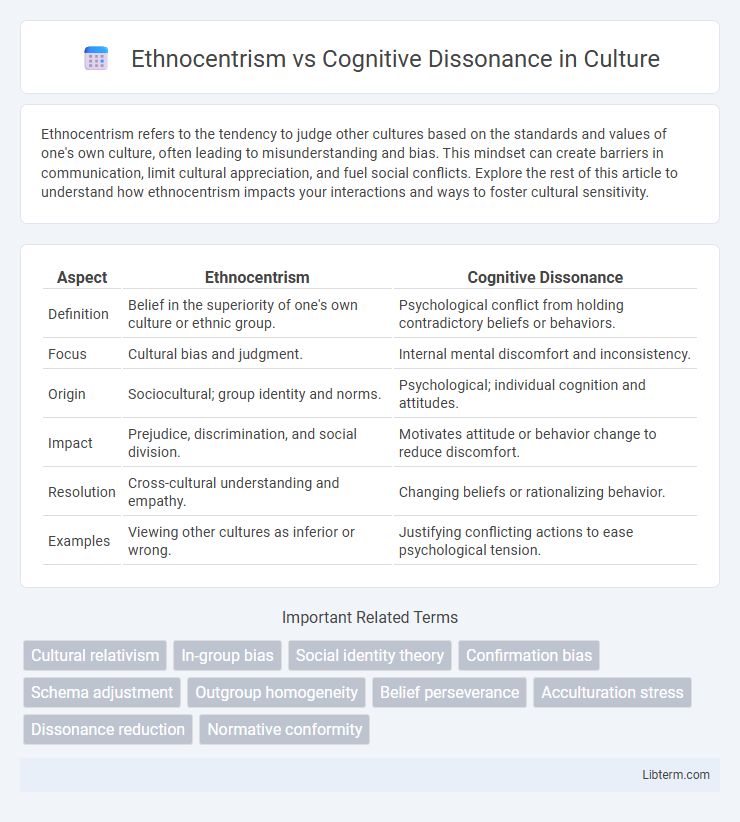Ethnocentrism refers to the tendency to judge other cultures based on the standards and values of one's own culture, often leading to misunderstanding and bias. This mindset can create barriers in communication, limit cultural appreciation, and fuel social conflicts. Explore the rest of this article to understand how ethnocentrism impacts your interactions and ways to foster cultural sensitivity.
Table of Comparison
| Aspect | Ethnocentrism | Cognitive Dissonance |
|---|---|---|
| Definition | Belief in the superiority of one's own culture or ethnic group. | Psychological conflict from holding contradictory beliefs or behaviors. |
| Focus | Cultural bias and judgment. | Internal mental discomfort and inconsistency. |
| Origin | Sociocultural; group identity and norms. | Psychological; individual cognition and attitudes. |
| Impact | Prejudice, discrimination, and social division. | Motivates attitude or behavior change to reduce discomfort. |
| Resolution | Cross-cultural understanding and empathy. | Changing beliefs or rationalizing behavior. |
| Examples | Viewing other cultures as inferior or wrong. | Justifying conflicting actions to ease psychological tension. |
Understanding Ethnocentrism: Definition and Origins
Ethnocentrism is the tendency to evaluate other cultures based on the standards and values of one's own culture, often leading to biases and misunderstandings. This concept originates from social psychology and anthropology, highlighting how group identity and cultural conditioning influence perception and behavior. Understanding ethnocentrism involves recognizing its role in shaping intercultural interactions and the challenges it poses to social harmony and cognitive flexibility.
Defining Cognitive Dissonance: Psychological Foundations
Cognitive dissonance is a psychological theory describing the mental discomfort experienced when an individual holds contradictory beliefs, values, or attitudes simultaneously. This dissonance motivates efforts to achieve internal consistency by altering beliefs or behaviors to reduce the psychological tension. The foundation of cognitive dissonance reflects core principles in social psychology, emphasizing how individuals strive for harmony between cognition and action to maintain emotional stability.
Key Differences Between Ethnocentrism and Cognitive Dissonance
Ethnocentrism involves evaluating other cultures based on the standards of one's own culture, often leading to cultural bias and prejudice. Cognitive dissonance refers to the psychological discomfort experienced when holding conflicting beliefs or behaviors, prompting efforts to restore internal consistency. The key difference lies in ethnocentrism being culturally focused and externally oriented, whereas cognitive dissonance is an internal psychological process related to belief reconciliation.
Ethnocentrism in Cultural Perceptions and Social Behavior
Ethnocentrism shapes cultural perceptions by promoting the belief that one's own cultural group is superior, often leading to biased social judgments and stereotyping of others. This bias influences social behavior by fostering in-group favoritism and out-group discrimination, which can hinder cross-cultural communication and collaboration. Understanding ethnocentrism is crucial for addressing social conflicts and promoting inclusivity in diverse societies.
Cognitive Dissonance and Decision-Making Conflicts
Cognitive dissonance arises when individuals face conflicting beliefs, values, or attitudes, leading to psychological discomfort that significantly influences decision-making processes. This internal conflict often causes people to rationalize choices or avoid information that challenges their existing viewpoints, thereby impacting their ability to make objective decisions. Understanding cognitive dissonance is crucial for resolving decision-making conflicts, as it highlights how mental discomfort drives individuals to seek consistency, often at the expense of critical evaluation and openness to alternative perspectives.
Psychological Impact of Ethnocentrism on Group Dynamics
Ethnocentrism fosters in-group favoritism and out-group bias, intensifying social divisions and reinforcing stereotypes within group dynamics. This psychological impact heightens collective identity but often leads to prejudice, reducing empathy and cooperation among diverse groups. Persistent ethnocentric attitudes contribute to cognitive dissonance when confronted with contradictory information about other cultures, causing emotional discomfort and resistance to change.
How Cognitive Dissonance Shapes Beliefs and Attitudes
Cognitive dissonance shapes beliefs and attitudes by creating psychological discomfort when individuals encounter information that conflicts with their existing values or opinions. To reduce this discomfort, people often adjust their beliefs, selectively interpret evidence, or dismiss contradictory information, reinforcing their original worldview. This mental process maintains internal consistency and influences how individuals perceive and respond to ethnocentric attitudes within their social groups.
Intersections: When Ethnocentrism Leads to Cognitive Dissonance
Ethnocentrism often triggers cognitive dissonance when individuals confront cultural practices or beliefs that challenge their own worldview, creating psychological discomfort due to conflicting values. This intersection manifests as a defensive mechanism where people either reject non-native customs or rationalize their biases to maintain a consistent self-concept. Understanding how ethnocentric attitudes induce cognitive dissonance is essential for fostering intercultural empathy and reducing prejudice.
Overcoming Ethnocentrism and Reducing Cognitive Dissonance
Overcoming ethnocentrism involves fostering cultural empathy and promoting intercultural communication to appreciate diverse perspectives and reduce bias. Reducing cognitive dissonance requires recognizing conflicting beliefs and adopting adaptive strategies such as cognitive restructuring or seeking new information to restore mental consistency. Both processes benefit from increased self-awareness and openness to change, enhancing personal growth and social harmony.
Real-World Examples: Ethnocentrism vs Cognitive Dissonance in Society
Ethnocentrism often manifests in immigration policies that favor native cultural practices, such as resistance to multicultural education in countries like France, reflecting a belief in cultural superiority. Cognitive dissonance arises when individuals support freedom and equality but simultaneously harbor or rationalize discriminatory attitudes, as seen in workplace diversity challenges in the United States. These examples demonstrate how ethnocentric biases can conflict with personal or societal values, prompting mental discomfort and shifts in attitudes to reduce dissonance.
Ethnocentrism Infographic

 libterm.com
libterm.com